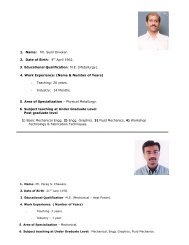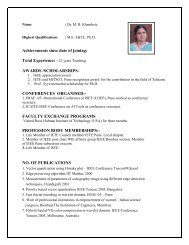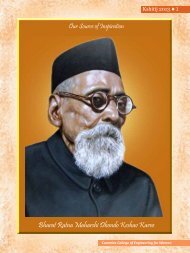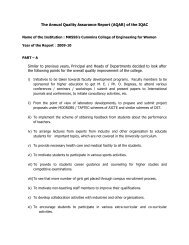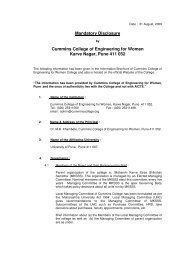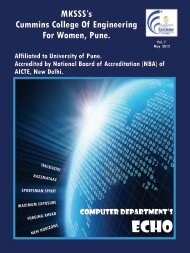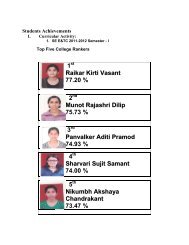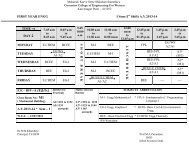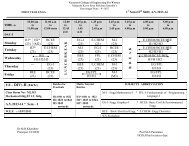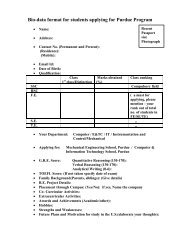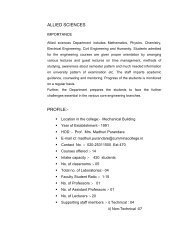Tarang - Cummins College of Engineering for Women
Tarang - Cummins College of Engineering for Women
Tarang - Cummins College of Engineering for Women
You also want an ePaper? Increase the reach of your titles
YUMPU automatically turns print PDFs into web optimized ePapers that Google loves.
TA R A NG Volume 7 / Issue 2 - April 2012<br />
EDITORIAL<br />
Hello friends,<br />
As always the new semester begins with great enthusiasm, and with it comes a<br />
new edition <strong>of</strong> ‘<strong>Tarang</strong>’. Yet again, we have articles regarding newer technologies,<br />
some <strong>of</strong> which are poised to change the electronics world completely. Articles about<br />
ecoATM, Aakash Tablet and QR codes are <strong>of</strong> great relevance today. We then take a<br />
plunge into bioelectronics with a cancer detecting electronic nose. We also have a<br />
very in<strong>for</strong>mative article about PCB designing. To top it all up, we have the<br />
achievements <strong>of</strong> all students and staff in the last semester.<br />
We take this opportunity to express our gratitude to Pr<strong>of</strong> S. Kulkarni and<br />
Pr<strong>of</strong> Manasi Pathade <strong>for</strong> their guidance and support. We would like to thank all<br />
our readers and contributors <strong>for</strong> their enthusiasm and support.<br />
- <strong>Tarang</strong> team<br />
Message From HOD<br />
1. <strong>Tarang</strong> magazine is a plat<strong>for</strong>m <strong>for</strong> the students <strong>of</strong> the E &TC department<br />
to give a fillip to their written expression in the <strong>for</strong>m <strong>of</strong> articles on<br />
technical and general subjects.<br />
2. The magazine also is one <strong>of</strong> the means <strong>for</strong> students to keep abreast with<br />
the latest developments in the electronics and telecom field.<br />
3. The book review is expected to create the abilities in the students to write<br />
an intellectual critique <strong>of</strong> a book written by a reputed author.<br />
4. I am sure, this magazine will go a long way in preparing our students to<br />
face the outside world on an intellectual plane.<br />
5. I congratulate the editorial team and the contributors <strong>of</strong> articles and the<br />
book review.<br />
1<br />
Pr<strong>of</strong>. Sukumar Kulkarni<br />
HoD, E & TC Dept.<br />
comp1 / D / trang / March 2012 / March <strong>Tarang</strong> 2012
TA R A NG Volume 7 / Issue 2 - April 2012<br />
THE INCREDIBLY SHRINKING TRANSISTOR<br />
Saili R. Chougule (TE E&TC B)<br />
F or most <strong>of</strong> us the word ‘Transistors’ brings<br />
about a myriad <strong>of</strong> emotions. We’ve already dealt with<br />
a complete subject on the tiny device and I‘am sure<br />
almost everyone shuns at the memory <strong>of</strong> their SSDC<br />
exam. So what’s the big deal about the ‘Transistor’<br />
Why is it so important Or is it<br />
In answer to this many eminent scientists as well<br />
as most <strong>of</strong> our teachers would probably tell us – “Forget<br />
inventions like air conditioning, television, computer and<br />
the Internet. The single most important invention <strong>of</strong> the<br />
20th century was the transistor.”<br />
The little-talked-about transistor is the building<br />
block <strong>of</strong> the processor. Without the transistor, our<br />
servers would be almost three stories high and our<br />
laptops would have been props on Star Trek. Our<br />
televisions would still use vacuum tubes, and our cars<br />
wouldn’t guide us to the nearest restaurant. Without<br />
the transistor, would Micros<strong>of</strong>t Corp. and Google Inc.<br />
become giants Would geeks have become the cool,<br />
rich guys driving BMWs<br />
Probably not.<br />
Sixty years ago — on Dec. 16, 1947, to be exact<br />
the transistor was invented at Bell Labs. The first<br />
transistor was about the size <strong>of</strong> the palm <strong>of</strong> a hand,<br />
with a depth <strong>of</strong> two matchboxes stacked on top <strong>of</strong> each<br />
other. The discovery <strong>of</strong> transistors has ignited a series<br />
<strong>of</strong> advances that has changed the way people listen to<br />
their favourite music, do their jobs, pay their bills,<br />
educate themselves and buy everything from books<br />
to used toaster ovens. Transistors inside pacemakers<br />
keep our hearts going. The PC and the Internet have<br />
been phenomena, but how usable and ubiquitous would<br />
they be without millions <strong>of</strong> tiny transistors running<br />
inside laptops, desktops and servers Intel estimates<br />
that about 10 quintillion (or a 1 followed by 19 zeros)<br />
transistors are shipped each year. That’s 10,000 times<br />
the number <strong>of</strong> ants on Earth!!<br />
After so many advances and miniaturization one<br />
would wonder, what is left <strong>for</strong> us to do now The answer<br />
is plain and clear- more miniaturization, smaller<br />
devices, more functions in lesser chip space.<br />
We shall now discuss emerging technologies<br />
which strive towards the same goal-<br />
CARBON NANOMETER TRANSISTORS<br />
When today’s transistors (silicon metal-oxidesemiconductor<br />
field-effect transistors, or Si MOS-<br />
FETs) are shrunk, they lose their ability to effectively<br />
control electric current, a problem called short-channel<br />
effects. For this reason, researchers have been<br />
modifying the Si MOS-FET design in an attempt to make<br />
the transistor per<strong>for</strong>m better at sub-10-nm gate lengths,<br />
but these devices still face per<strong>for</strong>mance challenges. In<br />
a new study, the engineers have discarded silicon<br />
altogether and turned to single-walled CNTs.<br />
Engineers have built the first carbon nanotube<br />
(CNT) transistor with a channel length below 10 nm.<br />
Not only can the tiny transistor sufficiently control<br />
current, it does so significantly better than predicted<br />
by theory. It even outper<strong>for</strong>ms the best competing<br />
silicon transistors at this scale, demonstrating a<br />
superior current density at a very low operating voltage.<br />
Due to their superior electrical properties and<br />
ultrathin (1-2-nm diameter) bodies, CNTs have been<br />
proposed as a replacement <strong>for</strong> silicon <strong>for</strong> several years.<br />
Their ultrathin bodies should allow CNTs to maintain<br />
gate control <strong>of</strong> the current in a transistor even at short<br />
channel lengths, potentially enabling them to avoid<br />
short-channel effects. The IBM team’s sub-10-nm CNT<br />
transistor is the first to demonstrate these advantages.<br />
Until the engineers built the sub-10-nm CNT<br />
transistor, no one knew that they would per<strong>for</strong>m this<br />
well. Theories predicted that CNTs with ultrathin<br />
channels would experience a loss <strong>of</strong> gate control as<br />
2
TA R A NG Volume 7 / Issue 2 - April 2012<br />
well as a loss <strong>of</strong> drain current saturation in the output,<br />
both <strong>of</strong> which would degrade per<strong>for</strong>mance.<br />
The reason that theory projected a loss <strong>of</strong> gate<br />
control <strong>for</strong> nanotube transistors below 15 nm or so is<br />
related to other unique transport physics <strong>for</strong> nanotube<br />
devices. The carrier effective masses (mass <strong>of</strong><br />
electrons) are very small <strong>for</strong> nanotubes compared to<br />
other semiconductors, meaning they can tunnel or leak<br />
in the device more easily. This is one <strong>of</strong> the reasons<br />
that theories had suggested a loss <strong>of</strong> gate control,<br />
because these ‘light’ carriers would begin tunnelling<br />
uncontrollably when the lengths became too small.<br />
When the engineers fabricated several individual<br />
transistors on the same nanotube, the smallest having<br />
a channel length <strong>of</strong> just 9 nm, they observed that the<br />
tiniest transistor exhibited superb switching behaviour<br />
and drain current saturation, defying predictions. When<br />
compared to the best-per<strong>for</strong>ming sub-10-nm Si<br />
transistors <strong>of</strong> varying designs and diameters, the 9-<br />
nm CNT transistor had a diameter-normalized current<br />
density <strong>of</strong> more than four times that <strong>of</strong> the best silicon<br />
transistor. And it exhibited this impressive current<br />
density at a low operating voltage (0.5 volts), which is<br />
important <strong>for</strong> reducing power consumption.<br />
QUANTUM TRANSISTORS<br />
The word quantum never fails to fascinate us.<br />
Make a quantum sized transistor and probably the face<br />
<strong>of</strong> the electronics industry will change <strong>for</strong>ever. So great<br />
is the allure <strong>of</strong> quantum devices that several types are<br />
under development. One variant is the double–electronlayer<br />
tunneling transistor (Deltt) built by researchers<br />
at Sandia National Laboratories, in Albuquerque, N.M.<br />
Structurally, the Deltt positions an insulating barrier<br />
between two two-dimensional wells. In operation,<br />
electrons quantum mechanically tunnel from one well<br />
to the other through the barrier. Device speed benefits<br />
from the tunneling process, which is much faster<br />
than the drift <strong>of</strong> electrons, let alone <strong>of</strong> slower holes,<br />
across a channel. Sandia researchers label the two<br />
wells as source and drain, to correspond with<br />
conventional transistors.<br />
A well is <strong>for</strong>med by surrounding one region holding<br />
a bevy <strong>of</strong> free-electron energy states with another<br />
region having a dearth <strong>of</strong> them. The well is deemed<br />
two-dimensional when it is so narrow in one dimension<br />
that electron motion is restricted to the plane <strong>of</strong> the<br />
well. An electron can tunnel through the barrier only if<br />
its energy and its momentum in the plane <strong>of</strong> the well<br />
are both conserved. In other words, an electron can<br />
tunnel only if the energy state <strong>of</strong> the quantum well on<br />
the other side <strong>of</strong> the barrier is equal in energy and<br />
momentum to the state the electron originally occupied.<br />
In general, when no voltage is applied to the device,<br />
there are no matching states in the two wells, and the<br />
device is <strong>of</strong>f. But when the energy level <strong>of</strong> the electrons<br />
in one well is shifted appropriately, the energy states<br />
line up opposite each other and tunnelling occurs—a<br />
condition known as resonance. Applying voltage to a<br />
control gate or biasing one <strong>of</strong> the wells relative to the<br />
other will shift the energies. In practice, both voltages<br />
are applied in operating the Deltt.<br />
Another variant <strong>of</strong> quantum transistor is the much<br />
“quantum dot” it consists <strong>of</strong> just seven atoms in a single<br />
silicon crystal. Despite its incredibly tiny size - a mere<br />
four billionths <strong>of</strong> a metre long - the quantum dot is a<br />
functioning electronic device, the world’s first, created<br />
deliberately by placing individual atoms. It can be used<br />
to regulate and control electrical current flow like a<br />
commercial transistor but it represents a key step into<br />
a new age <strong>of</strong> atomic-scale miniaturisation and superfast,<br />
super-powerful computers.<br />
The discovery was reported in the journal Nature<br />
Nanotechnology by a team from the UNSW Centre<br />
<strong>for</strong> Quantum Computer Technology (CQCT) and the<br />
University <strong>of</strong> Wisconsin-Madison.<br />
The technology <strong>for</strong> placing individual atoms on a<br />
surface, the scanning tunnelling microscope, has<br />
existed <strong>for</strong> two decades. But until now nobody has<br />
been able to use it to make atomic-precision devices<br />
capable <strong>of</strong> processing electronic inputs from the<br />
macroscopic world. Although the quantum effect<br />
transistor marks a critical milestone toward what<br />
many people are calling ‘nanoelectronics,’ much<br />
developmental work remains to be done.<br />
Manufacturing and interconnecting such small<br />
structures reliably in production quantities demand<br />
3
TA R A NG Volume 7 / Issue 2 - April 2012<br />
techniques that have yet to be developed. Another<br />
impact <strong>of</strong> their minute size is that whole new circuit<br />
architectures will have to be devised.<br />
Who knows some years <strong>for</strong>th semiconductor<br />
technology might become as redundant as vacuum<br />
tubes are today.<br />
G G G<br />
AMAZING INVENTION !!! ELECTRONICS IN<br />
DETECTING AND CURING ‘CANCER’<br />
Sejal Badgujar (SE E&TC)<br />
In what can prove to be a breakthrough in<br />
detecting cancer, a research team at Technion- an<br />
Institute <strong>of</strong> Technology in Israel has developed an<br />
electronic nose, which can sniff out malignant head<br />
and neck cancer tumours which are <strong>of</strong>ten hard to<br />
diagnose otherwise.<br />
According to them, it picks up on microscopic<br />
chemical changes that are emitted in the breath <strong>of</strong><br />
people with the two cancers, compared to those<br />
without the disease.<br />
The Nano Artificial Nose has been tested on a small<br />
sample group but there are hopes it could one day be<br />
used as a routine test on the cancers. Patients develop<br />
tumours <strong>of</strong> the head, neck, salivary glands and mucus<br />
membranes. These cancers are hard to spot early and<br />
are <strong>of</strong>ten not diagnosed until the cancer has spread to<br />
other parts <strong>of</strong> the body. In fact, <strong>for</strong> their study, the scientists<br />
collected breath samples from 82 patients who had head<br />
and neck cancer, lung cancer or were cancer-free.<br />
Cancer researchers at Albert Einstein <strong>College</strong> <strong>of</strong><br />
Medicine <strong>of</strong> Yeshiva University have found a biomarker<br />
in head and neck cancers that can predict whether a<br />
patient’s tumour will be life threatening.<br />
The biomarker is considered particularly promising<br />
because it can detect the level <strong>of</strong> risk immediately<br />
following diagnosis. This discovery could become a<br />
component <strong>of</strong> a new test to guide how aggressively<br />
those with head and neck tumours should be treated.<br />
Previous ef<strong>for</strong>ts to identify biomarkers <strong>for</strong> guiding<br />
treatment <strong>of</strong> head and neck cancer have not developed<br />
anything clinically useful <strong>for</strong> patients.<br />
Head and neck cancers, the sixth most common<br />
malignancy among men worldwide, most <strong>of</strong>ten affect<br />
the mouth, back <strong>of</strong> the throat and larynx (voice box).<br />
Smoking and alcohol use are major risk factors. Only<br />
half <strong>of</strong> patients are still alive more than five years after<br />
diagnosis — a survival rate that hasn’t changed in 40<br />
years.<br />
In their study, researchers took tissue samples<br />
from tumours and nearby healthy tissue <strong>of</strong> 123 head<br />
and neck cancer patients at Montefiore and measured<br />
levels <strong>of</strong> 736 members <strong>of</strong> a class <strong>of</strong> RNA molecules<br />
known as microRNAs. Certain members <strong>of</strong> this family<br />
<strong>of</strong> RNAs, which regulate protein abundance in cells,<br />
are abnormally expressed in head and neck cancers<br />
as well as every other malignant cell type yet<br />
examined. Of all the microRNAs measured, one in<br />
particular — miR-375 — stood out <strong>for</strong> being the most<br />
down-regulated (i.e. expressed at low levels) in head<br />
and neck tumours compared with its levels in adjacent<br />
normal tissue.<br />
There entire head and neck cancer group is<br />
working to identify and refine additional biomarkers to<br />
create a useful clinical test or personalized genetic<br />
signature to help individual patients get the best<br />
possible treatment.<br />
We can judge from above invention that everything<br />
can be done with the help <strong>of</strong> ‘ELECRONICS’<br />
G G G<br />
4
TA R A NG Volume 7 / Issue 2 - April 2012<br />
This ATM takes your old mobiles, hands back cash!!<br />
Kalyani S. Upadhye (SE E&TC B)<br />
W e always talk about new tablets,<br />
laptops and other devices. But what do we<br />
do the older ones Here is the solution-<br />
EcoATM.<br />
The machine can recycle gadgets<br />
giving them a better home. It is twice the<br />
size <strong>of</strong> our regular ATM. It has a large touch<br />
screen and a big metal mouth where we place our old<br />
mobile or MP3 player or any other gadget. The next<br />
step the machine does is that it takes pictures <strong>of</strong> the<br />
device to find out what shape it is in. Then we connect<br />
our gadget to the machine. The machine figures out<br />
whether the devices internals are working properly or not.<br />
When its analysis is completed, it<br />
gives a menu <strong>of</strong> the number <strong>of</strong> electronics<br />
recycling companies that are willing to pay<br />
<strong>for</strong> the gadget. If we accept, the company<br />
will recycle the gadget to obtain the usable<br />
metals from it. For eg. if we give an old<br />
phone which is in complete disorder, the<br />
machine might still return a dollar.<br />
E-waste is increasing and it is difficult to handle<br />
it. Collection bins <strong>for</strong> E-waste is also very rare. Online<br />
selling can also be done but it is a bit tedious. Also<br />
with this machine we avoid online fees. Hopefully we<br />
will be seeing more <strong>of</strong> these machines in the near future.<br />
G G G<br />
QR Codes<br />
Neha Shah (SE E&TC B)<br />
Not too long ago, I heard about young adults in<br />
Japan getting QR codes tattooed on their bodies.<br />
Crazy! Isn’t it I was already Googling ‘QR code tattoos’<br />
to uncover the truth. You only need to take a look to<br />
find QR codes on arms and faces. Not only that we<br />
see QR codes in advertisements, business cards,<br />
posters, in malls, on t-shirts and many more places.<br />
So what is a QR code QR code stands <strong>for</strong> Quick<br />
Response code. They have actually been in existence<br />
since 1994, be<strong>for</strong>e the internet was widely used and<br />
iPhones didn’t even exist. Thanks to Denso Wave, who<br />
created them, QR code is one <strong>of</strong> the most popular<br />
types <strong>of</strong> two-dimensional barcodes and was designed<br />
to allow its contents to be decoded at high speed.<br />
Wikipedia has a QR code specific website, QRpedia,<br />
a mobile web based system which uses QR codes to<br />
deliver Wikipedia articles to those in their preferred<br />
language and was only unveiled in April last year.<br />
Anyone who has a cellphone with a camera can<br />
read QR codes. All you need to do is download a reader<br />
(s<strong>of</strong>tware) which is freely available on many websites,<br />
scan the code and you are taken directly to the related<br />
URL .The data can be anything, your contact numbers<br />
or any text, a URL …just anything and it can certainly<br />
contain data that is more than 100 times larger than<br />
data in typical barcodes. You can also generate a QR<br />
code <strong>for</strong> your data. Like the one below will allow you<br />
read the same article on your mobiles.<br />
Let’s see few interesting applications <strong>of</strong> these<br />
magical codes:<br />
<br />
<br />
<br />
<br />
<br />
<br />
<br />
<br />
<br />
Books<br />
Tickets<br />
Restaurant menu cards<br />
Discount coupons<br />
Google maps<br />
RSS feeds<br />
Youtube videos<br />
PowerPoint (Keynote on a Mac)<br />
Newspapers (especially Pune Mirror)<br />
I really hope someone out there will begin to utilize<br />
QR codes <strong>for</strong> research in these ways. It’s not the<br />
future, it’s now !!<br />
G G G<br />
5
TA R A NG Volume 7 / Issue 2 - April 2012<br />
INNOWAYS - 2012<br />
National level project competition organized by KPIT <strong>Cummins</strong><br />
A ndroid is a Linux-based operating system <strong>for</strong><br />
mobile devices such as smart phones and tablet<br />
computers. It is developed by the Open Handset<br />
Alliance led by Google.It has seen a number <strong>of</strong> updates<br />
since its original release, each fixing bugs and adding<br />
new features. Each version is named, in alphabetical<br />
order, after a dessert - 2.3 Gingerbread, 3.0<br />
Honeycomb, 4.0 Ice Cream Sandwich, Key Lime Pie<br />
(Expected at the end <strong>of</strong> 2012).<br />
Android has a large community <strong>of</strong> developers<br />
writing applications (“apps”) that extend the<br />
functionality <strong>of</strong> the devices. I made an android app that<br />
can be used as a PowerPoint assist i.e. while giving a<br />
PowerPoint presentation an android phone can be<br />
used to change slides.<br />
Power point presentation is the most widely used<br />
tool in college by both students and our pr<strong>of</strong>essors.<br />
And mobile phone another most commonly used<br />
device. Clubbing the two together seemed fascinating.<br />
I thought this would be a useful Mobile Application and<br />
probably very convenient too.<br />
The basic ideas were<br />
1. Establishing a wireless mode <strong>of</strong> communication<br />
between the laptop and the mobile phone.<br />
2. Development <strong>of</strong> an environment.<br />
3. Using mobile as a mouse.<br />
Two separate codes were written, one <strong>for</strong> the<br />
server (laptop) the other <strong>for</strong> client (phone). Java was<br />
used to do the programming. I used eclipse (s<strong>of</strong>tware)<br />
As a reiteration <strong>of</strong> commitment to enhancing<br />
employability <strong>of</strong> the student community, Eaton and<br />
<strong>Cummins</strong> <strong>College</strong> <strong>of</strong> <strong>Engineering</strong> in association with<br />
Confederation <strong>of</strong> Indian Industries introduced the<br />
“Garnishing Talent” program. The program was<br />
focused on equipping students from vernacular, semivernacular<br />
and rural background with appropriate s<strong>of</strong>t<br />
and social skills critical to achieve individual and<br />
pr<strong>of</strong>essional success. The program leveraged Eaton’s<br />
6<br />
Chandni Sahay, 1 st prize winner,Innoways 2012<br />
to build up the java plat<strong>for</strong>m and added android plugins<br />
to it. In this application, I used java classes that<br />
helped me put the function <strong>of</strong> the mouse to go to the<br />
next slide and the previous slide. These functions were<br />
put in the lower volume button and the upper volume<br />
button respectively.<br />
This project was made by me <strong>for</strong> a project<br />
competition,Innoways, organized by KPIT <strong>Cummins</strong><br />
<strong>for</strong> third year students. There were two rounds <strong>of</strong> the<br />
competition. First round was held in our college and<br />
the final round took place in KPIT <strong>Cummins</strong>, Hinjewadi<br />
where it was held amongst the winners <strong>of</strong> different<br />
colleges.<br />
Winning <strong>of</strong> this competition was made possible<br />
by sheer guidance <strong>of</strong> our pr<strong>of</strong>essors. I would like to<br />
express my heartfelt gratitude to HOD Sir,<br />
Pr<strong>of</strong> S. Kulkarni <strong>for</strong> his guidance and moral support,<br />
Pr<strong>of</strong>. Anita Patil <strong>for</strong> encouraging me throughout, Pr<strong>of</strong><br />
Praful Meshram , IT department <strong>for</strong> giving an insight<br />
into this project.<br />
I would thank our Principal,Dr. Madhuri Khambete<br />
Ma’am, our college and KPIT <strong>Cummins</strong> <strong>for</strong> giving us<br />
such an auspicious plat<strong>for</strong>m and this knowledge<br />
enriching opportunity. I would also like to thank KPIT<br />
<strong>Cummins</strong> <strong>of</strong>ficials who came as judges to our college,<br />
Krishnan Kutty Sir, Rajendra Kango Sir and Swapnil<br />
Bhoyar Sir <strong>for</strong> their kind and supportive attitude towards<br />
us and also <strong>for</strong> giving us valuable inputs and<br />
suggestions on our projects.<br />
G G G<br />
Garnishing Talent - An Innovative Endeavor<br />
For Improvement<br />
Gunjan Phalak (TE E&TC B)<br />
association with leading academic institutions in Pune<br />
region and facilitated interactive sessions between<br />
students and experts from Eaton. The participants <strong>of</strong><br />
this program included 90 students from various<br />
departments’ namely mechanical, instrumentation,<br />
in<strong>for</strong>mation technology and electronics &<br />
telecommunications as identified through a defined<br />
assessment process.
TA R A NG Volume 7 / Issue 2 - April 2012<br />
Many students from the Electronics and<br />
Telecommunications Branch were privileged to have<br />
benefitted from this program that included various<br />
topics in the field <strong>of</strong> communication skills along with<br />
practical implementations <strong>of</strong> Group Discussions and<br />
Personal Interviews with experienced mentors from<br />
Eaton Corporation. The Garnishing Talent Program was<br />
inaugurated on 4th January 2012, in the presence <strong>of</strong><br />
eminent Corporate Lords. In order to facilitate effective<br />
learning <strong>of</strong> students, 10 Buddies were appointed so<br />
as to create a link between the students and mentors<br />
from the Industry. Buddies included Gunjan Phalak<br />
(Student Co Ordinator), Isha Ramdasi, Manasi<br />
Rashinkar, Sukhada Sathaye, Ishwari Unhale from the<br />
E&TC branch.<br />
In the 2 months that the program was<br />
implemented between 6th Jan and 7th March, students<br />
were made acquainted with varied skills such as<br />
English Basics, Presentation Skills, Social Networking,<br />
Time Management, Working with Generations and<br />
many more. Every Saturday, a Role Model Session<br />
was arranged with successful Corporate.<br />
The program was a great learning experience and<br />
facilitated exposure to the Corporate world outside <strong>of</strong><br />
the college. A big round <strong>of</strong> applause <strong>for</strong> Eaton<br />
Corporation, CII and <strong>Cummins</strong> <strong>College</strong> is in order <strong>for</strong><br />
this innovative endeavor that they have jointly started<br />
<strong>for</strong> the upcoming Engineers.<br />
G G G<br />
KiCAD: Easy Tool To Design Your PCBs<br />
Priyanka Kulkarni (BE E&TC)<br />
KiCad is an open source (GPL) integrated utility<br />
package that facilitates the use <strong>of</strong> the various programs<br />
required to draw schematics, layout PCBs, generate<br />
and check the production files. For manufacturing any<br />
PCB we have to go throw following procedure :<br />
KiCad helps us to follow this quickly and efficiently.<br />
The default KiCad window consists <strong>of</strong> 5 buttons (in<br />
order from left to right )the sub programs are:<br />
· EESchema - a schematic program<br />
· CVpcb - a program linking schematics to<br />
footprints<br />
· PCBnew - a PCB layout tool<br />
· GerbView - a gerber viewer<br />
· Bitmap2Component - a program <strong>for</strong> converting<br />
bitmaps <strong>for</strong> use on PCBs etc.<br />
Creating a new project is the first step to start<br />
with. In this project, all the files corresponding to one<br />
PCB are saved. Since we will be dealing mostly with<br />
postscripts, we will mainly concentrate on the first<br />
three sub-programs.<br />
EESchema :<br />
1. We can draw circuit diagrams using this 32 bit<br />
s<strong>of</strong>tware. Electrical connectivity is defined in these<br />
schematics using graphic representation <strong>of</strong> an electronic<br />
device. A schematic mainly consists <strong>of</strong> components,<br />
wires, labels, junctions, buses and power ports.<br />
Features :<br />
· We can select different components using built<br />
in libraries.<br />
· We can also create new components as per our<br />
requirement.<br />
7
TA R A NG Volume 7 / Issue 2 - April 2012<br />
· Hierarchical drawings, multi-sheets diagrams can<br />
be drawn.<br />
· There is hence no real limitation on the component<br />
count, number <strong>of</strong> component pins, connections,<br />
and sheets.<br />
· Many keyboard shortcuts are available so drawing<br />
become easy. For example,use <strong>of</strong> ‘m’ and ‘r’ to<br />
move and rotate your modules . One can also<br />
use ’v’ <strong>for</strong> editing value <strong>of</strong> component.<br />
· Power connections can be easily shown using built<br />
in Power library.<br />
· Automatic generation <strong>of</strong> the bill <strong>of</strong> material.<br />
· For clearness in the schematic, we can place<br />
purely graphical elements like bus entries,<br />
comments, and dotted lines to draw frames.<br />
Some conventional prefixes are used in naming<br />
any circuit. Example: resistors are named as Rn,<br />
transistors as Qn , ICs as Un and so on .<br />
4. The final step in EESchema is to generate the<br />
netlist. A netlist is a file which describes electrical<br />
connections between the components.<br />
A netlist thus contains :<br />
• The list <strong>of</strong> the components<br />
• The list <strong>of</strong> connections between components,<br />
called equipotential nets.<br />
CVPCB:<br />
CVPCB allows us to assign each component that<br />
appears in the netlist created by the Schematic<br />
program to the name <strong>of</strong> the footprint (i.e. the physical<br />
appearance <strong>of</strong> the component) which will represent it<br />
on a printed circuit board, and adds this in<strong>for</strong>mation to<br />
the netlist. We see a list <strong>of</strong> our symbols at the left and<br />
possible footprints at the right. Components can be<br />
assigned to their corresponding footprints manually or<br />
automatically. We can create our own footprints also.<br />
Mechanical dimensions <strong>of</strong> each component are<br />
important. Pad sizes, pin to pin distance, drill size<br />
should be verified.<br />
2. The control <strong>of</strong> the electrical rules (control E.RC.)<br />
is a facility provided by KiCad, which allows the<br />
detection <strong>of</strong> incorrect connections or omissions<br />
in the schematic.<br />
3. The next step is to annotate. There can be many<br />
resistors or ICs in one circuit diagram. To give<br />
each component a unique identity or labels, we<br />
must annotate the circuit diagram. Click the<br />
Annotate Tool, set the parameters if you want, and<br />
KiCad automatically numbers all the components.<br />
8
TA R A NG Volume 7 / Issue 2 - April 2012<br />
PCBNEW :<br />
Here the actual layout is designed.<br />
· On the right hand side, different layers in the PCB<br />
are mentioned. PCBNEW works on 16 layers <strong>of</strong><br />
copper, plus 12 technical layers (silk screen, solder<br />
mask, component adhesive, solder paste, drawings<br />
and comment etc.)Mostly we use front layer as<br />
component layer and back layer as solder layer.<br />
Every time choose your working layer properly.<br />
· First we should approximately decide the size <strong>of</strong><br />
our PCB then draw the border <strong>of</strong> PCB with the<br />
help <strong>of</strong> graphic line.<br />
· Then read the netlist. The modules will appear on<br />
the screen. Stuff them into the PCB outline you<br />
made.<br />
· Place the components in manner you want.<br />
· PCBNEW has an internal resolution <strong>of</strong> 1/10000<br />
inch. Modules can be rotated to any angle, with a<br />
step <strong>of</strong> 0.1 degree. Pads can be circular ,<br />
rectangular, oval or trapezoidal shape. We can<br />
add pads or extra modules later if needed.<br />
· The Module Editor can be accessed from the<br />
PCBNEW toolbar. The Editor allows creation or<br />
modification <strong>of</strong> a module from the PCB or a library<br />
and then saved to either.<br />
· Rat nest (real time the hairline indication) helps<br />
us to find out missing tracks. We cannot connect<br />
two pads without a connection specified in the<br />
netlist, thus maintain accuracy.<br />
· 3D viewer is provided to display the circuit board<br />
in 3 dimensions.<br />
· PCBNEW has an active Design Rules Check<br />
(DRC) which automatically indicates any error <strong>of</strong><br />
track layout in real time.<br />
· A netclass (Click on design rules -> design rules)<br />
specify:<br />
• The width <strong>of</strong> tracks and via diameters and drills.<br />
• The clearance between pads and tracks (or vias)<br />
We can create our new netclass to change the<br />
track width or clearance if required.<br />
The last but the important step in manufacturing<br />
point <strong>of</strong> view is to export the files or to plot the points in<br />
the <strong>for</strong>mat you want. Mostly we use POSTSCRIPT<br />
<strong>for</strong>mat. File got save in .ps <strong>for</strong>mat. Plot the layers you<br />
want such as front layer, back layer, front masking layer,<br />
silk print layer etc. Generate drill chart along with this.<br />
Give these files <strong>for</strong> film printing and then to print actual<br />
circuit board.<br />
In this way using KiCad we can easily develop<br />
our own PCB. This s<strong>of</strong>tware is freely available on<br />
internet. So you can download it along with libraries.<br />
Try this and enjoy the designing <strong>of</strong> your own Printed<br />
Circuit Boards.<br />
G G G<br />
The Four Engineers<br />
Once there were four engineers traveling in a car.<br />
While they were traveling to their destination the car stalled on them.<br />
The first engineer who was a mechanical engineer said, “don’t worry it’s probably engine<br />
problems. I”ll just pop open the hood and take a look at the motor”.<br />
The second engineer, who was an electrical engineer, said, “no, no ,no. it’s an electrical<br />
problem. Let me look at the fuse box and I’ll find the problem”.<br />
The third engineer, who was a chemical engineer, said, “its just a problem with the fuel.<br />
Flush all <strong>of</strong> the gas and replace it with new gas and you’ll see that the car will be fine.”<br />
Then the three engineers looked at the fourth who was a “Micros<strong>of</strong>t” computer engineer.<br />
And his response was... “Why don’t we just get out <strong>of</strong> the car, shut all <strong>of</strong> the doors, and then<br />
open them again and get back in and start it!”<br />
9
TA R A NG Volume 7 / Issue 2 - April 2012<br />
AAKASH LCAD TABLET THE CHEAPEST TABLET YET<br />
Ankita Paranjpe (SE E&TC C)<br />
T he Aakash LCAD (low cost access device) is<br />
an Android tablet computer jointly developed by the<br />
London-based company Datawind with the Indian<br />
Institute <strong>of</strong> Technology, Rajasthan. It was launched on<br />
5th October 2011. The tablet was developed as an<br />
initiative by the Ministry <strong>of</strong> Human Resources and<br />
Development under Government <strong>of</strong> India. The basic<br />
version costs a student only Rs 1,500 which is around<br />
$35. This is because <strong>of</strong> the subsidies that are <strong>of</strong>fered<br />
to students and institutions using the tablet. The<br />
commercial version which would have a few more<br />
features than the basic version would be marginally<br />
costlier. However, the Aakash LCAD Tablet still holds<br />
the distinction <strong>of</strong> being the world’s cheapest computing<br />
device.<br />
When we talk <strong>of</strong> the specifications provided in the<br />
tablet, experts believe that they are good but could have<br />
been better. The PC tablet is not meant <strong>for</strong> gaming<br />
purpose. It has in fact been developed especially <strong>for</strong><br />
students, and it would be right to say it meets that<br />
purpose. To understand this we must first take a look<br />
at the general specifications <strong>of</strong> the tablet.<br />
Specifications <strong>of</strong> Aakash LCAD Tablet –<br />
<br />
<br />
<br />
Size – 190.5×118.5×15.7mm<br />
Screen size – 7" resistive<br />
Weight – 350gms<br />
Operating System – Android 2.2<br />
<br />
<br />
Processor -366 MHz, plus Graphics<br />
Accelerator and HD Video Co-processor<br />
Memory -256 MB RAM<br />
<br />
Storage –2GB Micro SD card expandable up<br />
to 32GB<br />
Connectivity – 2 USB ports (full sized)<br />
Battery – 2100mAh<br />
Camera – External USB<br />
Network – Wi-Fi Enabled<br />
Web Browser – DataWind Accelerated<br />
Browser<br />
Modem – Inbuilt cellular and Subscriber Identity<br />
Module (SIM)<br />
Cost – Rs 2,276 (approximately $50) –<br />
Approximately Rs. 1500 <strong>for</strong> students<br />
The Salient Features <strong>of</strong> the Tablet<br />
The tablet can also be used as a mobile phone<br />
as it has facility <strong>for</strong> inserting SIM card and<br />
headphones<br />
The device is Wi-Fi and GPRS enabled<br />
It can also function as a 3G if dongle is enabled<br />
The <strong>for</strong>mats supported by the image viewer<br />
are –JPG, PNG, GIF and BMP<br />
The audio <strong>for</strong>mats the device supports are –<br />
WMA, AAC,MP3, WAV and AC3<br />
The tablet supports the following video <strong>for</strong>mats<br />
– MPEG2, MPE4, FLV and AVI<br />
Document <strong>for</strong>mats supported by the system<br />
are – DOCX, DOC, PPTX, PPT, XLSX, XLS,<br />
ODP and ODT<br />
It also has a Text editor and a PDF viewer<br />
Though the Aakash Tablet may not have a high<br />
speed processor or all the features required by the<br />
technical savvy, it is still a good device and an upgrade<br />
is expected soon.<br />
Finally…<br />
Computers and internet have taken over the world.<br />
The low priced Aakash Tablet will help close the great<br />
divide between those who can af<strong>for</strong>d a computer and<br />
those who cannot. With its low price the af<strong>for</strong>dability<br />
factor is taken care <strong>of</strong> and the functionality <strong>of</strong> the device<br />
is at par with the other computers.<br />
G G G<br />
10
TA R A NG Volume 7 / Issue 2 - April 2012<br />
BOOK REVIEW<br />
Shweta Hariharan (TE E&TC B)<br />
“W hat is the smallest constituent <strong>of</strong> a<br />
substance” This might have been one <strong>of</strong> the most<br />
popular question’s the science teacher asked you at<br />
school and without the slightest doubt you would have<br />
blurted out “An atom! “ The answer seemed so simple,<br />
didn’t it Well, in reality, the answer isn’t as simple as<br />
it seems. This is what theoretical physicist Harald<br />
Fritzsch tries to convey through his book “You Are<br />
Wrong , Mr Einstein!” in which he has described the<br />
history <strong>of</strong> quantum physics in one <strong>of</strong> the easiest<br />
manners.<br />
The book begins with a <strong>for</strong>eword by S L Glashow<br />
( who himself is a Nobel laureate) telling how quantum<br />
physics plays a very important role in our day to day<br />
life, from the desk we sit on, to the mobile phones that<br />
we just can’t do without nowadays. Dr. Fritzsch has<br />
used a very innovative technique <strong>of</strong> creating an<br />
imaginary conversation between great physicists<br />
which includes Newton, Einstein, Heisenberg,<br />
Feynman and Haller through which he tries to describe<br />
the concepts <strong>of</strong> quantum physics. The conversation<br />
starts with the basic definition <strong>of</strong> an atom and slowly<br />
sieves its way through to more complicated terrains<br />
like quarks, gluons, bosons etc. These terminologies<br />
may sound like Greek and Latin to most non-physicists<br />
but thanks to Fritzsch who again scores by his<br />
ef<strong>for</strong>tless simplicity, readers will not find it very difficult<br />
to understand. The author considerably brushes on<br />
the social life <strong>of</strong> these remarkable men, their personal<br />
rivalries but keeps them to a minimum and sticks to<br />
his field. It is pretty amusing when each <strong>of</strong> the physicists<br />
admit to one point that non <strong>of</strong> them understand quantum<br />
physics!<br />
One <strong>of</strong> the hindrances in this book is its monotony.<br />
It gets repetitive at numerous accounts. Also, the book<br />
loses its interactive essence and seems like a text book<br />
after a point. This book is a complete no-no <strong>for</strong> a person<br />
who has no physics/science background as the author<br />
has assumed the reader knows the basic concepts <strong>of</strong><br />
physics while writing the book.<br />
However, the book promises to enlighten you<br />
with this amazing science and in case you read the<br />
whole book you will surely not be disappointed. This<br />
book is a complete treat <strong>for</strong> all physics enthusiasts.<br />
On a lighter edge, in case you were to bump into<br />
Sheldon Cooper(from ‘The Big Bang Theory’) and<br />
want to strike a tete- a-tete with him, make sure<br />
you don’t miss this one!<br />
G G G<br />
What Thomas Edison’s Mother might have said to her son<br />
“Of course I’m proud that you invented the electric light bulb.<br />
Now turn it <strong>of</strong>f and go to bed !”<br />
11
TA R A NG Volume 7 / Issue 2 - April 2012<br />
Departmental Activities<br />
The various programs conducted by the department are as follows :<br />
1. Guest lecture on ‘Finance <strong>for</strong> Non - finance Pr<strong>of</strong>essionals’ by Qureish Shipchandler (Vice President – Industrial<br />
Audit, <strong>Cummins</strong> India Ltd) was organized on 25 th Dec 2011.<br />
2. Ericsson Excel Webinar Program <strong>for</strong> B.E. students by Ericsson India Ltd was conducted in Dec 2011 – Jan<br />
2012.<br />
3. Guest Lecture by Dr. Varadraj Bapat ( IIT Bombay), on ‘Nation is Career’ was arranged on 13 th Jan 2012 to<br />
inculcate ethical values in the students.<br />
4. KPIT <strong>Cummins</strong> announced a National level Project Competition – Innoways to nurture the spirit <strong>of</strong> Innovation<br />
and Excellence. KPIT <strong>Cummins</strong> selected 10 <strong>Engineering</strong> <strong>College</strong>s across India. <strong>Cummins</strong> <strong>College</strong> <strong>of</strong><br />
<strong>Engineering</strong> <strong>for</strong> <strong>Women</strong>, Pune was one <strong>of</strong> them.<br />
The Contest which was open to participation <strong>for</strong> 3 rd year B.E. /B.Tech students from Electronics, Electronics<br />
and Tele-communication, Computer Science and Instrumentation branches was announced in September<br />
2011. The students were free to choose a topic from a list <strong>of</strong> project areas given to them by KPIT <strong>Cummins</strong>.<br />
A team <strong>of</strong> experts from KPIT <strong>Cummins</strong> had visited the college on 17 th Feb 2012 <strong>for</strong> evaluation and the results<br />
were declared soon after the brilliant demonstration by the students. The head <strong>of</strong> the E&TC Department<br />
Pr<strong>of</strong>. Kulkarni welcomed the guests. The projects ‘Presentation Assist using Mobile’ by Chandni Sahay and<br />
‘Parking Assist using Mobile’ by Nupur Bhonge, Sukhada Sathaye and Ishwari Unhale shared the award <strong>of</strong><br />
Trophy. After the results were announced, Principal Dr. Madhuri Khambete thanked KPIT <strong>Cummins</strong> <strong>for</strong> giving<br />
the students the exposure to latest real world problems and the opportunity to apply their theoretical knowledge<br />
to practical applications. The programme was coordinated by Pr<strong>of</strong>. A. S. Patil.<br />
The best project groups were sent <strong>for</strong> the Tech Exhibition – Tecxpedition 2012, the theme <strong>of</strong> which was<br />
‘Technology 2025’ at KPIT <strong>Cummins</strong> in the month <strong>of</strong> March 2012. The first Prize <strong>of</strong> the competition was won<br />
by Chandni Sahay <strong>of</strong> T.E. E&TC.<br />
5. A project guidance workshop was conducted by the department <strong>for</strong> the third year E&TC students under the<br />
aegis <strong>of</strong> IEEE student chapter on 24 th Jan 2012.<br />
6. A special lecture on ‘Programmable Logic Controller’ was arranged <strong>for</strong> final year E&TC students in March<br />
2012. Pr<strong>of</strong>. Vaishali Upadhye (Instumentation Dept, CCOEW) was the invited speaker. Pr<strong>of</strong>. Vidya Sisale<br />
coordinated this activity.<br />
7. A visit to ‘Maharshi Karve Telephone Exchange, BSNL, Karve Road, Pune’ was arranged <strong>for</strong> final year E &<br />
TC students on 28 th and 29 th March 2012. Pr<strong>of</strong>. Shubhangi Choudhary and Pr<strong>of</strong>. Pratibha Vellanki coordinated<br />
this activity.<br />
8. Our college conducted the ‘ePGCON 2012’ conference pertaining to paper presentations on theses <strong>of</strong> M.E.<br />
Electonics and E &TC students <strong>of</strong> all the engineering colleges under University <strong>of</strong> Pune running M.E.<br />
Electronics and E & TC programs. The conference was held on 23 rd -24 th April 2012.<br />
9. A Santoor recital per<strong>for</strong>med by Pt.Dhananjay Daithankar accompanied by Pt.Ramdaas Palsule was organized<br />
by the Art Circle, Team. This event was co ordinated by Pr<strong>of</strong>. J. A. Mokashi & Pr<strong>of</strong>. Namrata Karandikar<br />
10. Activities under NSS cell: The following activities were conducted under NSS cell. The activities are<br />
coordinated by Pr<strong>of</strong>. M.A. Dixit (NSS Program Officer), Pr<strong>of</strong>. G.R. Padalkar, Mrs. A.R.Fukane <strong>of</strong> E &TC<br />
Department and NSS coordinators <strong>of</strong> other departments.<br />
12
TA R A NG Volume 7 / Issue 2 - April 2012<br />
Regular Activities :<br />
1. Book donation <strong>for</strong> the School at village Kalyan on 14 th Sept.2011.<br />
2. Engineer’s day celebration on 15 th sept.2011.<br />
3. Visit to ‘APLA GHAR’ anath ashram and vruddhashram on 17 th Sept.2011.<br />
4. Lecture on Traffic Rules on safe driving by Mr. Ajit Joshi from Rotary Club, Pune (West) & PUC checking <strong>of</strong><br />
vehicles at concessional rate on 29 th sept.2011.<br />
5. Visit to ‘Aadivasi Ashram Shala, Kamshet’ on 03 rd Oct.2011.<br />
6. A lecture session was conducted by Mrs. Abhyankar on child adopation on 04 th Oct.2011.<br />
7. Blood Donation Camp: It was held twice in the year : on 10 th Oct. 2011 and 21 st & 22 nd Feb.2012<br />
8. NSS volunteers worked as readers & writers <strong>for</strong> blind students <strong>for</strong> their Midsemester examination in<br />
Mahilashram High School <strong>of</strong> MKSSS<br />
9. NSS volunteers taught English grammer to XI std art students from Samstha.<br />
10. Students attended University level seminar on Health Awareness at Siddhivinayak <strong>College</strong> <strong>of</strong> Arts &<br />
Commerce, Pune on 01 st Feb. 2012.<br />
11. Donation <strong>of</strong> science lab equipment to school at village Kalyan on 8 th Feb.2012.<br />
12. Sessions were conducted <strong>for</strong> the subjects Science and English <strong>for</strong> the students <strong>of</strong> std VIII and X at Kalyan<br />
village on 10 th Feb.2012. Special Guidance was given to the Std. X students by the staff <strong>of</strong> Mahilashram High<br />
School.<br />
Special Camp :<br />
Our college has adopted village Kalyan, Tal. Haweli. It is just 35Kms away from Pune. We have conducted<br />
the special residential camp <strong>of</strong> 7 days at Kalyan from 10 th Jan.2012 to 16 th Jan.2012. Twenty one students<br />
attended the camp. Following activities were conducted <strong>for</strong> seven days such as-<br />
1. Inauguration <strong>of</strong> NSS camp on 10 th Jan.2012 at the hands <strong>of</strong> Pr<strong>of</strong>.N.D.Patil, LMC member <strong>of</strong> MKSSS, Exmember<br />
<strong>of</strong> Maharastra State Secondary & Higher Secondary Education Board, Pune, Ex-vice President <strong>of</strong><br />
Akhil Bhartiya Vidyarthi Parishad (Maharastra State).<br />
2. Swachhata : Volunteers cleaned Grampanchayat <strong>of</strong>fice area and area near two temples on 11 th Jan.2012.<br />
3. Medical Camp (Arogya Shibir) held on 11 th Jan.2012. Health checkup <strong>of</strong> children below 12 years was done<br />
by Dr. Navrange & Dr.Karandikar.<br />
4. Tree Plantation: Total <strong>of</strong> 40 trees like Mango and Ashoka were planted near Grampanchayat <strong>of</strong>fice, School<br />
campus, Pashu Vaidyakiya Rugnalaya on 12 th Jan.2011.<br />
5. Educational programs were conducted <strong>for</strong> school students <strong>of</strong> 8 th , 9 th , 10 th Standards. Such as career Guidance,<br />
study Techniques etc.<br />
6. Visit to Brick Kiln (Vit Bhatti) on 13 th Jan.2012.<br />
7. Trekking to Sinhagad <strong>for</strong>t.<br />
8. Visit to poultry farm on 14 th Jan.2012.<br />
9. Students worked in the farm and picked plants <strong>of</strong> Black Peas (Kala Vatana) also ploughed in the farm on 15 th<br />
Jan.2012.<br />
10. Visit to Bio-Gas Production Plant on 15 th Jan.2012.<br />
11. Function <strong>of</strong> Haldi Kumkum was organized <strong>for</strong> women from Kalyan on occasion <strong>of</strong> Makarsankranti on 15 th Jan.2012.<br />
12. Visit to milk dairy on 16 th Jan.2012.<br />
13. Mr. Mote (NSS Area Coordinator) conducted session <strong>for</strong> NSS volunteers. He also conducted mind games. He<br />
gave on the spot topics <strong>for</strong> street plays and they were per<strong>for</strong>med be<strong>for</strong>e the valedictory function on16 6th Jan.2012.<br />
G G G<br />
13
TA R A NG Volume 7 / Issue 2 - April 2012<br />
Staff Activities<br />
<br />
Heartiest congratulations to:<br />
<br />
Pr<strong>of</strong>. Pratibha Vellanki and Mrs. Anuradha Fukane <strong>for</strong> successfully completing M.E. Signal Processing<br />
course.<br />
Pr<strong>of</strong>. P.V.S. Shastry, Pr<strong>of</strong>. A.S. Patil, Pr<strong>of</strong>. N.G. Palan, Pr<strong>of</strong>. B. V. Pathak, Pr<strong>of</strong>. M.S. Borse, Pr<strong>of</strong>. S. R.<br />
Choudhary, Pr<strong>of</strong>. M.A. Dixit, Pr<strong>of</strong>. A.R. Khedkar, Pr<strong>of</strong>. S. L. Sahare and Pr<strong>of</strong>. S.A. Paranjape <strong>for</strong> Ph.D.<br />
registrations.<br />
<br />
Conferences / Workshops Attended:<br />
S.N. Name <strong>of</strong> Staff Seminar / Conference /Workshop / Symposia/STTP/Training Program/Invited lecturer<br />
1 Pr<strong>of</strong>. S. V. Kulkarni Workshop Chaired a session on ‘Optical Fiber 7 th Jan 2012<br />
Communication’ at<br />
Dyanganga <strong>College</strong><br />
<strong>of</strong> <strong>Engineering</strong> & Research Pune<br />
2 Pr<strong>of</strong>. P. V. S. Shastry International International conference on ‘Computational 15 th -18 th Dec 2011<br />
conference Intelligence and Computer Research’<br />
<strong>for</strong> IEEE at CAPE Institute Of technology<br />
Levengipuram, Kanayakumari<br />
3 Pr<strong>of</strong>. Mrs. B. V. Pathak International CCSIT-12 International conference, 2 nd -4 th Jan 2012<br />
conference Bangalore<br />
International International Conference Of Advanced<br />
conference Computing For Electronics And Electrical<br />
<strong>Engineering</strong> held at VIT Hotel Mumbai 25 th -27 th March12<br />
Workshop Two day Workshop on Speech Signalling<br />
processing at RSCOE, Pune<br />
24 th and 25 th Feb.12<br />
4 Pr<strong>of</strong>. Mrs. S. R. National World Congress on<br />
Chaudhary conference In<strong>for</strong>mation and Technologies 11 th -14 th Dec. 2011.<br />
(WICT 2011) in Mumbai<br />
International International Conference & 24 th & 25 th Feb 2012<br />
Conference Workshop on Emerging<br />
Trends in Technology 2012 in<br />
Mumbai. (Selected)<br />
Workshop Workshop on Syllabus 9 th Jan 2012<br />
Discussion <strong>of</strong> BE (E&TC) on<br />
Telecommunication Switching<br />
Systems at Nutan Maharashtra<br />
Institute <strong>of</strong> Engg. & Technology,<br />
Talegaon Pune,<br />
5 Pr<strong>of</strong>. M. K. Pote. Workshop Workshop on ‘instructional 7th Jan2012.<br />
methodologies <strong>of</strong> Optical<br />
Fiber Communication,<br />
Dnyanganga <strong>College</strong> <strong>of</strong> engg.<br />
And research, Pune,<br />
14
TA R A NG Volume 7 / Issue 2 - April 2012<br />
S.N. Name <strong>of</strong> Staff Seminar / Conference /Workshop / Symposia/STTP/Training Program/Invited lecturer<br />
6 Dr. Mrs. P. P. National National Conference on 7 th – 9 th Dec., 2011.<br />
Shingare Conference Machine Vision & Image<br />
Processing MVIP, 2011<br />
7 Pr<strong>of</strong> Ms Padma International International Conference Of 25 th -27 th March 2012<br />
Hirave conference Advanced Computing For<br />
Electronics And Electrical<br />
<strong>Engineering</strong> held at VIT Hotel, Pune<br />
Papers Presented<br />
Sr. Name <strong>of</strong> Title <strong>of</strong> The Paper Name <strong>of</strong> the National/ International Date<br />
No. Staff Conference<br />
1. Pr<strong>of</strong>. P. V. S. “High Throughput Sub- International conference on 15 th -18 th Dec 2011<br />
Shastry Pipelined Implementation Computational Intelligence and<br />
Of AES Algorithm”<br />
Computer Research <strong>for</strong> IEEE at<br />
CAPE Institute Of technology<br />
Levengipuram, Kanayakumari<br />
2. Pr<strong>of</strong>. Mrs. A. S. “ Study <strong>of</strong> the EEG International Conf <strong>of</strong> Signal 25 th -27 th May 2012.<br />
Patil signals <strong>of</strong> Human Brain Processing & Pattern Recognition<br />
<strong>for</strong> the analysis <strong>of</strong><br />
at Delhi<br />
emotions’,<br />
3. Pr<strong>of</strong>.Mrs.A.S. DWT Based Video in International conference <strong>for</strong> Real 24 th and 25 th July 2011<br />
Patil Video Digital Time Video<br />
Watermarking <strong>for</strong> Real<br />
Time Video<br />
4. Pr<strong>of</strong>. Mrs. “Comparison between CCSIT-12International conference,<br />
B. V. Pathak different feature Bangalore<br />
extraction techniques to<br />
identify the Emotion To be published in Springer 2 nd -4 th Jan 2012<br />
‘Anger’ in speech “ LNISCST 85, pp 647-653, 2012.<br />
5. Pr<strong>of</strong>. Mrs. B. V. FxLms Algorithm <strong>for</strong> International Conference Of 25 th -27 th March 2012<br />
Pathak Feed<strong>for</strong>ward ANC Advanced Computing For<br />
System<br />
Electronics And Electrical<br />
<strong>Engineering</strong> held at VIT Hotel<br />
Mumbai<br />
6. Pr<strong>of</strong>. Mrs. S. R. “An Enhanced Intrusion World Congress on In<strong>for</strong>mation 11 th -14 th Dec. 2011.<br />
Chaudhary detection System using and Technologies (WICT 2011) in<br />
Adaptive Acknowledgment Mumbai<br />
based Algorithm” .<br />
15
TA R A NG Volume 7 / Issue 2 - April 2012<br />
Sr. Name <strong>of</strong> Title <strong>of</strong> The Paper Name <strong>of</strong> the National/ International Date<br />
No. Staff Conference<br />
7. Pr<strong>of</strong>. Mrs. S. R. “Per<strong>for</strong>mance Analysis International Conference & 24 th & 25 th Feb 2012<br />
Chaudhary <strong>of</strong> an OFDM system Workshop on Emerging Trends<br />
using Channel coding in Technology 2012 in Mumbai.<br />
Techniques”<br />
8. Pr<strong>of</strong>. Ms Padma FxLms Algorithm <strong>for</strong> International Conference Of 25 th -27 th March 2012<br />
Hirave Feed<strong>for</strong>ward ANC Advanced Computing For<br />
System<br />
Electronics And Electrical<br />
<strong>Engineering</strong> held at VIT<br />
Hotel Mumbai<br />
9. Pr<strong>of</strong>. Ms.Vellanki “Enhanced Stereo International May 2011<br />
Pratibha Matching Technique Journal(IJCSI),Volume8,<br />
Using Image Gradient Issue 3<br />
For Improved Search<br />
Time”<br />
10. Pr<strong>of</strong>.Ms.Shukla “Low power RF Anteena International Journal <strong>of</strong> April 2011.<br />
Shambhavi Design <strong>for</strong> BAN” Computing volume 1,<br />
issue 2<br />
11. Pr<strong>of</strong>.Ms.Shukla “Methodology <strong>for</strong> Low International Journal <strong>of</strong> Computing April 2011.<br />
Shambhavi Power RF Antenna volume 1, issue 2<br />
design <strong>for</strong> Body Area<br />
Network “,<br />
Faculty as Resource Person in Workshop / Seminars / Conferences :<br />
Sr. Name <strong>of</strong> Brief Description Date Organized by<br />
No.<br />
Staff<br />
1 Pr<strong>of</strong>. S. V. Guest lecture: H.F. and 14 th November 2011 H.Q. ,Police<br />
Kulkarni V.H.F. communications Wireless,<br />
Maharashtra state,<br />
Pashan Road, Pune.<br />
2 Pr<strong>of</strong>.Mrs.A.S Judge <strong>for</strong> a paper presentation 2 nd March 2012. MMCOE, Pune<br />
Patil<br />
competition <strong>for</strong> a National<br />
level technical event-<br />
Dextirity 2012- organized by<br />
MMCOE<br />
3 Pr<strong>of</strong>. Mrs. S. N. Expert Lecture :”Direct 30 th September 2011. MMCOE, Pune<br />
Ohatkar<br />
Sequence Spread Spectrum”<br />
4 Pr<strong>of</strong>. Mrs. S. N. Invited <strong>for</strong> “FE ONLINE 1 st ,9 th &13 th University <strong>of</strong> Pune<br />
Ohatkar Examination Question paper June 2011<br />
Update Meeting<br />
5 Mrs.Anuradha Appointed as International 11th, 14th Mumbai, India<br />
R.Fukane Programme Committee December 2011<br />
member <strong>of</strong> ‘World Congress<br />
on In<strong>for</strong>mation and<br />
Communication Technologies<br />
(WICT 2011)’ organized by<br />
MIR labs U.S.<br />
16
TA R A NG Volume 7 / Issue 2 - April 2012<br />
Sr. Name <strong>of</strong> Brief Description Date Organized by<br />
No.<br />
Staff<br />
6 Mrs.Anuradha Worked as International December 20-22 , 2011 Indian Institute <strong>of</strong><br />
R.Fukane Program Committee Technology (IIT)<br />
member <strong>of</strong> ‘IEEE<br />
Roorkee, India,<br />
International Conference on<br />
organized by IEEE<br />
S<strong>of</strong>t Computing <strong>for</strong> Problem<br />
Computer society<br />
Solving (SoCProS 2011)<br />
and Machine<br />
Intelligence<br />
Research labs U.S.<br />
at Roorkee,<br />
7 Mrs.Anuradha Worked as International 07-09 Oct 2011. organized by IEEE<br />
R.Fukane Program Committee member Computer society<br />
<strong>of</strong> IEEE International Conference<br />
Intelligence<br />
and Machine on Computational<br />
Research labsU.S.<br />
Intelligence and<br />
at Gwalior, India on<br />
Communication Networks<br />
(CICN-2011),<br />
8. Mrs.Anuradha Worked as International 3-5 June 2011 organized by IEEE<br />
R.Fukane Program Committee member Computer society<br />
<strong>of</strong> ‘IEEE International<br />
and Machine<br />
Conference on<br />
Intelligence<br />
Communication Systems and<br />
Research labs U.S.<br />
Network Technologies<br />
at Jammu, India<br />
(CSNT-2011)’<br />
G G G<br />
17
TA R A NG Volume 7 / Issue 2 - April 2012<br />
Students Achievement<br />
1. Ms. Suvarna Athavale is selected as the Best Outgoing Student <strong>for</strong> this academic year.<br />
2. Ms. Pooja Keskar has won the ‘Murthy Prize <strong>for</strong> Excellence - <strong>for</strong> Best Per<strong>for</strong>mance in Sports.’<br />
3. Ms. Amruta Narayanpure and Ms. Nimita Shinde has passed the GATE examination with the score 98.98<br />
and 98.85 respectively.<br />
4. Ms. Bilwa jadhav is selected <strong>for</strong> MS program at Purdue University, USA with full scholarship and research<br />
assistantship.<br />
5. The following students participated in National ROBOCON competition held at Balewadi stadium on 2 nd<br />
march 2012:- Roma Panjabi, Nishi Shah, Revati Nalawade, Pooja Mehta, Chaitrali Joshi, Shivani Phadke,<br />
Neha Belapurkar, Priyanka Kulkarni (Team Leader) and Meera Kulkarni.<br />
6. The following students have been placed in companies shown against each:-<br />
KPIT <strong>Cummins</strong><br />
Chaitrali Eksambekar<br />
V Vandana<br />
Madhura patil<br />
Upajnya Shetty<br />
Sanya Joseph<br />
Shweta Vij<br />
Rucha kUlkarni<br />
ZS Associates<br />
Ankita Praharaj<br />
John Deere<br />
Prajakta Mane<br />
Pooja Keskar<br />
SuvarnaAthawale<br />
Neha Brahmankar<br />
Anvita Upadhyay<br />
Shruti Sharma<br />
Texas Instruments<br />
Meghana Manavazi<br />
<strong>Cummins</strong> India Ltd<br />
Bhagyashree Vispute<br />
Infosys<br />
Megha Dhole<br />
Namrata Somani<br />
Bilwa Jadhav<br />
Varsha Shivkumar<br />
Nikita Singh<br />
Trupti kadam<br />
Shruti Wangikar<br />
Arti Dayma<br />
Prajakta Gokhale<br />
Ankita Lalmunde<br />
Sneha Bijlani<br />
Gauri Thange<br />
Shruti Wadhokar<br />
Priyanka Kulkarni<br />
Sharvari Malunjkar<br />
Gauri Kelkar<br />
Meha Sinha<br />
Piyusha Vasekar<br />
Gayatri Chiplunkar<br />
Astha Ganjoo<br />
Capgemeni<br />
Kulkarni Prajakta<br />
18
TA R A NG Volume 7 / Issue 2 - April 2012<br />
Ruchita Badave<br />
Geometric<br />
Nivedita Ingle<br />
Madhura Pichare<br />
Chinmayee Pai<br />
Eaton<br />
Mrunmayi Sardesai<br />
Honeywell<br />
Kamble Jyoti<br />
WIPRO<br />
Deloitte<br />
Tata Motors<br />
Aditi Sinnarkar<br />
Khusboo Khatri<br />
Vaibhavi Kulkarni<br />
Shambhavi Tambulwadkar<br />
Shruti Naik<br />
Avanti Vyas<br />
Ruchita Katiyar<br />
Meenu Sasidharan<br />
Priyanka Sawhney<br />
IBM<br />
Wipro VLSI<br />
AGC Essar<br />
Ericssion<br />
Syntel<br />
Bosch<br />
Sneha Rathi<br />
N Monisha<br />
Talandage Kavita<br />
Shukla Kriti<br />
Aneesha Dumbre<br />
Shinde Nimita<br />
Mansa Ramdas<br />
Sweta Ghadge<br />
Name Class Competion Position won and place<br />
Anita Sharma SE Paper presentation 2 nd in Melange, VIT; Paper selected among top 12 in<br />
‘Cognizance’ IIT ROORKEE<br />
Project Competition<br />
Selected <strong>for</strong> mentorship & scholarship by EATON<br />
Pallavi Bade SE Kho-Kho 2 nd in COEP-Zest, CCOEW-Pentacle, & VIT-Melange<br />
DeepikaHange,<br />
Chavan Akshata,<br />
ShilpaKarad<br />
Meera Kulkarni SE Circuit designing 2 nd in VIIT- Perception<br />
Sania S. Mane, SE Football 1 st at COEP-Zest, CCOEW-Pentacle, & AIT-Pace<br />
Shalaka Kulkarni<br />
Geetika Dadheech SE Robo-race 3 rd at IIT-Khagarpur- Kshitij<br />
Manasi Bhide SE 8 th National ice 2 bronze medals in 500mtrs and 1000mtrs at Shimla<br />
skating championship<br />
49 th Roller Skating 2 bronze medals in 300mtrs timetrial and road,<br />
Federation <strong>of</strong> India and 1 silver medal in 500mtrs at Bengaluru<br />
Nationals<br />
Amrita Honap SE Paper Presentation 2 nd at Modern COE- M-Pulse<br />
Shweta<br />
Tembhurnikar<br />
Saniya Khan SE Aeromodelling 2 nd at VIIT-Perception<br />
Apurva Gaikwad<br />
Megha Guralvar<br />
Manansa Patil SE Hair decoration 2 nd at CCOEW<br />
Palvi Shrigiri<br />
(pre-gandhar)<br />
19
TA R A NG Volume 7 / Issue 2 - April 2012<br />
Name Class Competion Position won and place<br />
Dhanashri Patil SE Snap Hunt 1 st at Triz-CCOEW<br />
Shalaka Kulkarni SE Long jump, Football, 2 nd at CCOEW<br />
Cricket<br />
Throw ball<br />
1 st at CCOEW<br />
Sonam Shah, SE Paper Presentation 2 nd at VIIT- Perception<br />
VaidehiHoshing<br />
Neha Shaah SE Paper Presentation 2 nd at PCCOE<br />
KalyaniUpadhye<br />
Vrushali Naikwadi SE Nail Art 3 rd in Gandhar CCOEW<br />
Sapna Sonkavde<br />
Vrushali Naikwadi SE Cricket, Throwball 2 nd and 1 st respectively at Gandhar-CCOEW<br />
Handball<br />
2 nd at intercollegiate event<br />
Mayuri Deshpande, SE VictrizionRobo Race 1 st prize in Best Design at Innovation 2K12, CCOEW<br />
Amrita Honap,<br />
Priyanka Babar,<br />
Harshada Kelkar<br />
Kanchan Mate, T.E. INNOWAYS 2012 Qualified<br />
Ruta Kokil<br />
Shambhavi<br />
Balsubramanian,<br />
Prachi Pawar,<br />
Ankita Makhicha,<br />
Purva Kulkarni,<br />
Namrata,<br />
Shravya Peddireddy<br />
Shweta Hariharan T.E. Head publicity <strong>of</strong> Innovation 2k12<br />
Neha Kulkarni T.E. 100m relay 3 rd prize<br />
Purva Kulkarni T.E. Solo singing 2 nd prize Gandhar<br />
Chinmayee Pai BE Completed yoga teacher training from authentic yoga<br />
school. Now a certified yoga teacher<br />
Bilwa Jadhav BE Selected <strong>for</strong> MS at Purdue University with full<br />
scholarship and research assistantship<br />
Pooja Keskar BE Football Won Golden Boot award at Zest and Pentacle and<br />
Best Player award at Pace<br />
Khushboo Khatri BE Table Tennis Part <strong>of</strong> winning team at : DaminiPart <strong>of</strong> runners<br />
up team at :Zest, COEP Pentacle, CCOEWUnify,<br />
Symbiosis M-sports, Modern COE Melange, VIT<br />
20



